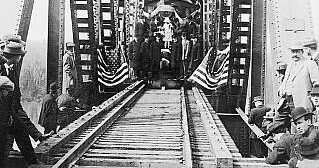
The Ben Maxwell Collection photo’s description was:
A group of men and one young lady are standing on a locomotive engine on the railroad bridge or on the tracks immediately in front of the engine. Most of the men are attired in long black overcoats and black hats. The girl wears light clothes and holds a bouquet of flowers. The occasion is the dedication of the Dallas-Falls City Railroad bridge at Salem on March 15, 1913.
March 15, 1913, was a day to celebrate in Salem and the surrounding communities. The Portland, Eugene and Eastern Railroad was ushering in a new era of rail service to the Cherry City on its new, five-span steel bridge across the Willamette River. Construction on the project began in May 1912, and anticipation steadily grew in Salem ahead of the dedication. But who was the girl who ushered in the first train across the bridge?
It turns out she was a bit of a local celebrity. She was Helen West, the 10-year-old daughter of Gov. Oswald West and his wife, Mabel.
Being a politician’s daughter brought Helen West publicity other Salem children likely would not have received. She was singled out for her performance in the musical comedy “A Night in Bohemia,” held at the Grand Theatre when she was 6.
“Perhaps the one that will create the greatest impression will be the appearance of little Helen West. … Little Helen West appears at the opportune moment and no one can exactly describe the beauty of the thing. It must be seen and heard for full appreciation,” the Daily Oregon Statesman wrote in its Jan. 23, 1909, edition.
Helen West made the newspaper with a conversation she had with her father after attending church, something the Daily Oregon Statesman writer noted they didn’t do with regularity, at least in the writer’s opinion. Churchgoing notwithstanding, Helen West also received attention from the Salem newspapers for her horse-riding skills, winning a blue ribbon in April 1910 atop her Shetland pony.
When Theodore Roosevelt visited Salem in April 1911, Helen West was there, too, presenting the former president with an Oregon grape, the state flower. Helen’s father was by now the state’s governor.
Later that year, she played a part in commuting a convict’s death sentence. The governor was willing to let the convict hang, if not for the pleas of the man’s daughter as well as what his own daughter would think. The Oregon Statesman wrote in its Sept. 6, 1911, edition that Gov. West asked his daughter if she knew what was bothering him, and she said “I don’t think I’d let him hang, daddy.”
The paper wrote, “The governor’s lips closed tight, for the lisping of his daughter sealed West’s verdict so far as the governor was concerned.”
“What you say goes, Helen,” he replied. “(Jesse) Webb won’t hang.”
With her father’s position leading Oregon, and his past as railroad commissioner, it likely wasn’t a surprise that Helen West would have a place in one of the region’s biggest events two years later, one that was declared a city holiday by Salem Mayor B.L Steeves. The governor also was aboard the engine, just not in as prominent place as Helen.
The Oregon Statesman gave a detailed report about the official opening in the March 16, 1913, edition:
The start was made from the West Salem side at 11:38. In the seat of honor on the engine pilot, which was prettily decorated with bunting, sat demure little Helen West, daughter of Governor West, who was to have the honor of strewing gorgeous red and white carnations in the pathway of the official train.
With every ounce of steam that the engine could muster, the heavy train got a flying start and took the grade leading to the bridge at a lively clip. Up the long incline of the trestle it went and soon the bridge itself, decked with flags and bunting, was reached. Here the speed was slackened and Miss West began scattering flowers to the right and left of the track. Some of the blooms fell into the Willamette and drifted down with the current, carrying with them, as it were, to other cities, the message that Salem was that day coming into her own as the logical railroad center of the state.
… A foot from the barrier the train came to a standstill, and Mark Woodruff, publicity man for the P.E. & E. (Portland, Eugene and Eastern railroad), cut the cords that kept the flags in place and the engine passed through. Dozens of photographers worked feverishly to get as many different pictures of the triumphay pageant as they could before the train got out of range. The motion picture man turned his crank some more and followed the train with his lens until it had passed off the bridge.
In April, the Bligh Theatre advertised a film showing “The new Oregon Bridge. Miss Helen West dedicates new entrance to Salem.”
Oswald West served a single term as governor, leaving office in 1915. He and his family later moved to Portland, where he practiced law. Helen West eventually had a sister, Jean, who was born in 1918. Helen graduated from Portland’s Lincoln High School and later Mills College in Oakland, California.
Helen West later got married and had two daughters. She returned to Portland and served as a real estate broker for more than 30 years, according to her obituary published in The Oregonian. Helen West Stone died Jan. 28, 1986, at age 83.
The bridge continued to be used for train traffic until the early 1990s. The city of Salem purchased the bridge, trestle and right of way to Northwest Wallace Road for $1 in 2004. The bridge was placed on the National Register of Historic Places in 2006.
On April 18, 2009, the bridge reopened to pedestrians and bicyclists.
The Ben Maxwell Collection consists of more than 5000 photographs donated to the Salem Public Library by the estate of Mr. Ben Maxwell, a noted Salem photographer and historian who died in 1967. Maxwell was a native of Salem, where he was born in 1898. He attended college at Oregon State University where he studied history and journalism. He started working with the Capital Journal newspaper in 1939. Because he packed his camera on every quest for historical stories, he was able to illustrate his articles for readers of the Capital Journal, the Oregon Journal, the Oregonian, and several magazines.
He recorded on film at least 13 governors, old-timers now gone, covered bridges now missing, and buildings and homes no longer standing. The collection includes copies of rare early Oregon photographs taken by others which have in turn been copied over and over by later researchers and feature story writers. This collection is a work in progress and many additional photographs remain to be scanned. The collection can be accessed at: https://photos.salemhistory.net/digital/collection/max
The City of Salem’s Historic Preservation Program staff within the Community Development Department in collaboration with the Salem Historic Landmarks Commission are in the process of completing an inventory of this collection and working to confirm and verify the content and narratives associated with all the photographs in this collection. Please contact Salem’s Historic Preservation Officer, Kimberli Fitzgerald at [email protected] with any suggestions, historic facts, or questions you might have about these historic photos.
STORY TIP OR IDEA? Send an email to Salem Reporter’s news team: [email protected].
SUPPORT OUR WORK – We depend on subscribers for resources to report on Salem with care and depth, fairness and accuracy. Subscribe today to get our daily newsletters and more. Click I want to subscribe!









